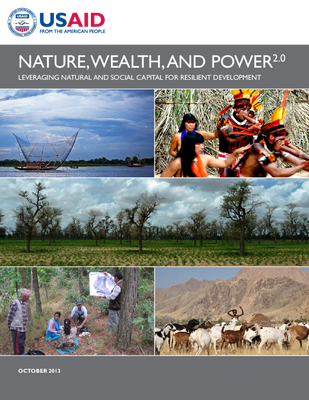Nature, Wealth, Power 2.0: Leveraging Natural and Social Capital for Resilient Development

Author(s): Anderson, Jon, Colby, Mike, McGahuey,Mike, Mehta, Shreya
Publication Date: 2013
DOWNLOAD FILEThis volume is a sequel to the original Nature, Wealth, & Power framework paper (NWP1), produced in 2002. That document, although focused on rural Africa, was found useful by a variety of development practitioners around the world, and elicited significant interest from different disciplines and regions from both practical and theoretical perspectives. The world context has changed since 2002, and development theory and practice have also evolved. Therefore, in 2012, USAID initiated an assessment and updating of the NWP framework. This second framework paper (NWP2) is targeted at practitioners involved in the design, implementation, and evaluation of natural resource–based rural development activities around the world, trying to make them more equitable, efficient, and effective. We also hope it will be useful to policy makers who are designing policies, laws, and administrative instruments to spur rural development. It does not claim to be a sure-fire recipe for success, but is an updated framework compiled from and consisting of best practices. Featured January, 2014.
Information relevant to Learning Questions:
Are enabling conditions in place to support a sustainable enterprise?
- Stakeholder alignment, diversification
- Market demand, access to credit/capital
- Ownership, governance
- Government requirements, policies for enterprises, business alliances
- Financial management capacity, technical capacity
- Inputs, infrastructure
- Benefit sharing, targeted participants, combined strategic approaches, biodiversity linkage, policies for and enforcement of resource use, external disturbance
Does the enterprise lead to benefits to stakeholders?
- Increased income for participants
- Non-cash benefits
Do the benefits lead to positive changes in attitudes and behavior?
- Attitudes regarding sustainable use of resources
- Behaviors regarding sustainable use of resources
Does a change in stakeholders’ behaviors lead to a reduction to threats to biodiversity (or restoration)?
- Agriculture and aquaculture
- Biological resource use
- Climate change and severe weather
Does a reduction in threats (or restoration) lead to conservation?
- Forest ecosystems
- Freshwater ecosystems
- Grassland ecosystems
- Marine ecosystems
- Species
Enterprise Types:
- Crops
- Livestock
- Sustainably harvested timber products
- Non-timber forest products
- Sustainably harvested fish and shellfish
- Aquaculture and mariculture
- Marine/freshwater ecotourism
- Terrestrial ecotourism
Document type
- Case-study
- Report

